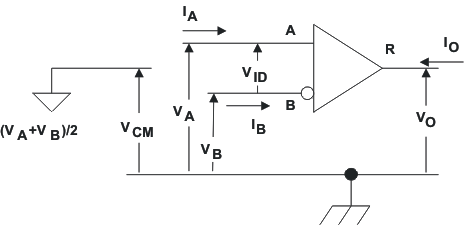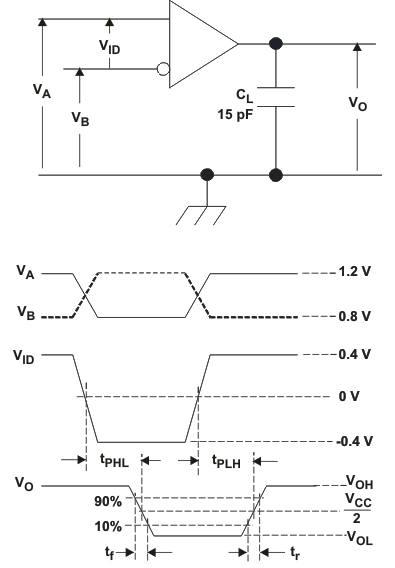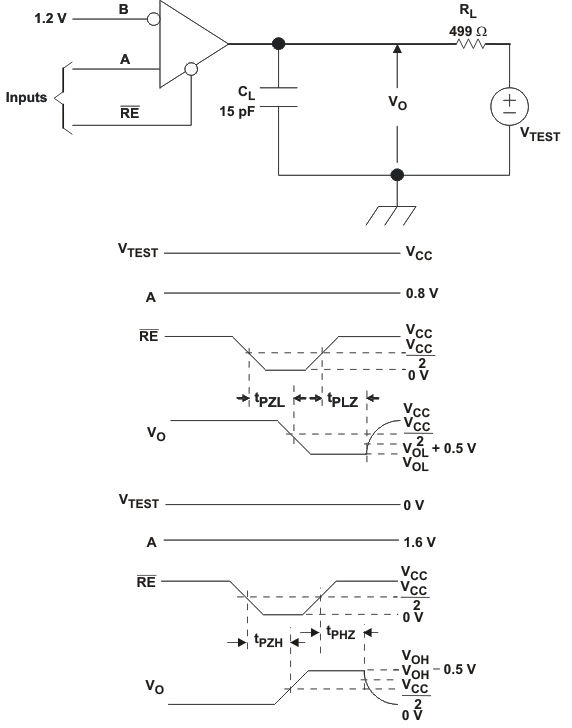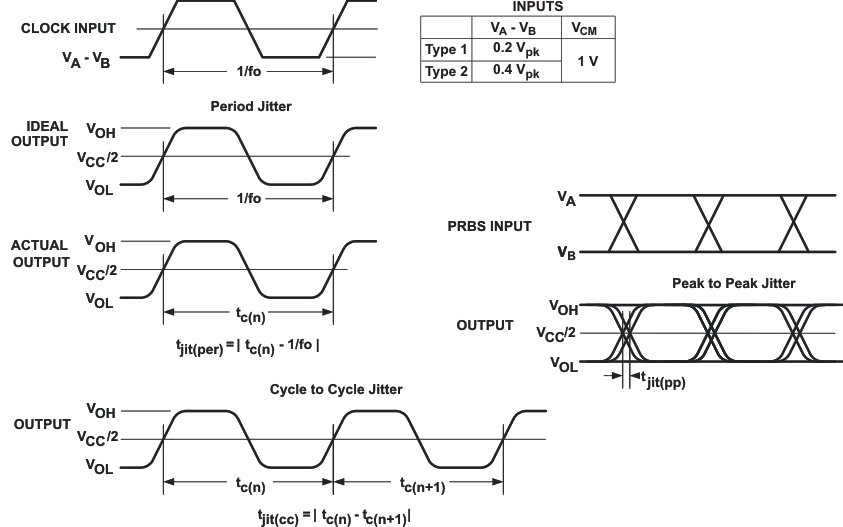JAJSTH4A December 2009 – March 2024 SN65MLVD048
PRODUCTION DATA
- 1
- 1 特長
- 2 アプリケーション
- 3 概要
- 4 Pin Configuration and Functions
- 5 Specifications
- 6 Parameter Measurement Information
- 7 Device Functional Modes
- 8 Device and Documentation Support
- 9 Revision History
- 10Mechanical, Packaging, and Orderable Information
パッケージ・オプション
メカニカル・データ(パッケージ|ピン)
- RGZ|48
サーマルパッド・メカニカル・データ
- RGZ|48
発注情報
6 Parameter Measurement Information
 Figure 6-1 Receiver Voltage and Current Definitions
Figure 6-1 Receiver Voltage and Current DefinitionsTable 6-1 Type-1 Receiver Input Threshold Test Voltages
| APPLIED VOLTAGES | RESULTING DIFFERENTIAL INPUT VOLTAGE | RESULTING COMMON-MODE INPUT VOLTAGE | RECEIVER OUTPUT(1) | |
|---|---|---|---|---|
| VIA | VIB | VID | VIC | |
| 2.400 | 0.000 | 2.400 | 1.200 | H |
| 0.000 | 2.400 | –2.400 | 1.200 | L |
| 3.400 | 3.365 | 0.035 | 3.3825 | H |
| 3.365 | 3.400 | –0.035 | 3.3825 | L |
| –0.965 | –1 | 0.035 | –0.9825 | H |
| –1 | –0.965 | –0.035 | –0.9825 | L |
(1) H= high level, L = low level, output state assumes receiver is enabled (
RE = L)
Table 6-2 Type-2 Receiver Input Threshold Test Voltages
| APPLIED VOLTAGES | RESULTING DIFFERENTIAL INPUT VOLTAGE | RESULTING COMMON-MODE INPUT VOLTAGE | RECEIVER OUTPUT(1) | |
|---|---|---|---|---|
| VIA | VIB | VID | VIC | |
| 2.400 | 0.000 | 2.400 | 1.200 | H |
| 0.000 | 2.400 | –2.400 | 1.200 | L |
| 3.400 | 3.265 | 0.135 | 3.3325 | H |
| 3.4000 | 3.335 | 0.05065 | 3.3675 | L |
| –0.865 | –1 | 0.135 | –0.9325 | H |
| -0.935 | –1 | 0.065 | –0.9675 | L |
(1) H= high level, L = low level, output state assumes receiver is enabled (
RE = L)

A. All input pulses are supplied by a generator
having the following characteristics: tr or tf ≤ 1ns,
Frequency = 1MHz, duty cycle = 50 ± 5%. CL is a combination of a
20%-tolerance, low-loss ceramic, surface-mount capacitor and fixture capacitance
within 2 cm of the D.U.T.
B. The measurement is made on test equipment with a
–3dB bandwidth of at least 1GHz.
Figure 6-2 Receiver Timing Test Circuit and Waveforms
A. All input pulses are supplied by a generator
having the following characteristics: tr or tf ≤ 1ns,
frequency = 1MHz, duty cycle = 50 ± 5%.
B. RL is 1% tolerance, metal film, surface mount, and located within 2 cm of the D.U.T
C. CL is the instrumentation and fixture capacitance within 2 cm of the D.U.T. and ±20%. The measurement is made on test equipment with a –3dB bandwidth of at least 1GHz.
Figure 6-3 Receiver Enable/Disable Time Test Circuit and Waveforms
A. All input pulses are supplied by the Agilent 81250 Parallel BERT Stimulus System with plug-in E4832A.
B. The cycle-to-cycle jitter measurement is made on a TEK TDS6604 running TDSJIT3 application software.
C. All other jitter measurements are made with an Agilent Infiniium DCA-J 86100C Digital Communications Analyzer.
D. Period jitter and cycle-to-cycle jitter are
measured using a 125MHz 50 ± 1% duty cycle clock input. Measured over 75K
samples.
E. Deterministic jitter and random jitter are
measured using a 250Mbps 215-1 PRBS input. Measured over
BER = 10-12
Figure 6-4 Receiver
Jitter Measurement Waveforms